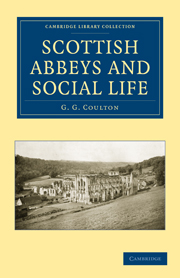Book contents
- Frontmatter
- Contents
- LIST OF ILLUSTRATIONS
- Preface
- Chapter I Celtic Monachism
- Chapter II The Monastic Rules
- Chapter III Monastic Revenues
- Chapter IV How Endowments Came (I)
- Chapter V How Endowments Came (II)
- Chapter VI Monks and Parishes (I)
- Chapter VII Monks and Parishes (II)
- Chapter VIII Charity (I)
- Chapter IX Charity (II)
- Chapter X Monk and Peasant (I)
- Chapter XI Monk and Peasant (II)
- Chapter XII Monastic Housekeeping
- Chapter XIII Church and Scriptorium
- Chapter XIV The Monastic Chronicler
- Chapter XV Schools
- Chapter XVI Art and Learning
- Chapter XVII Professions and Business
- Chapter XVIII Visitation (I)
- Chapter XIX Visitation (II)
- Chapter XX A Voice from the Cloister
- Chapter XXI Conclusion
- Appendixes
- List of Authorities
- Index
Chapter X - Monk and Peasant (I)
Published online by Cambridge University Press: 05 August 2011
- Frontmatter
- Contents
- LIST OF ILLUSTRATIONS
- Preface
- Chapter I Celtic Monachism
- Chapter II The Monastic Rules
- Chapter III Monastic Revenues
- Chapter IV How Endowments Came (I)
- Chapter V How Endowments Came (II)
- Chapter VI Monks and Parishes (I)
- Chapter VII Monks and Parishes (II)
- Chapter VIII Charity (I)
- Chapter IX Charity (II)
- Chapter X Monk and Peasant (I)
- Chapter XI Monk and Peasant (II)
- Chapter XII Monastic Housekeeping
- Chapter XIII Church and Scriptorium
- Chapter XIV The Monastic Chronicler
- Chapter XV Schools
- Chapter XVI Art and Learning
- Chapter XVII Professions and Business
- Chapter XVIII Visitation (I)
- Chapter XIX Visitation (II)
- Chapter XX A Voice from the Cloister
- Chapter XXI Conclusion
- Appendixes
- List of Authorities
- Index
Summary
Just as the records, when closely scrutinized, warn us against expecting too much from the monasteries in the way of direct almsgiving, so we must guard with equal care against the frequent exaggerations of modern writers with regard to the monks’ indirect services towards the poor. Those services are indisputable; in this direction, the abbeys were for centuries among the most beneficent of social forces. But, here also, we must keep due proportion. That which stood in the very forefront in 1100 a.d may be very small compared with all that has since been developed by the natural advance of social science, and by populations among whom war, whether foreign or civil, is no longer the rule but the exception, however lamentable. The medieval standard of poor relief or hospital treatment would not satisfy the world of today; nor, again, would any exact imitation of medieval landlordism. I have worked out this theme at some length in my Medieval Village, but must deal with it briefly again here, in the light of the Scottish evidence.
As to agriculture, we must clearly distinguish between two entirely different questions: What did the monks do as landlords? and: What did they do with their own hands? For their own handiwork, the evidence is mainly negative. True, both the Benedictine and the Augustinian Rule definitely command handiwork ; but this was one of the precepts most early and most completely neglected. Therefore in this field it is even more necessary than in most others to note carefully the date with which we are dealing. One clear indication of handiwork comes from the early twelfth century.
- Type
- Chapter
- Information
- Scottish Abbeys and Social Life , pp. 119 - 131Publisher: Cambridge University PressPrint publication year: 2010First published in: 1933

